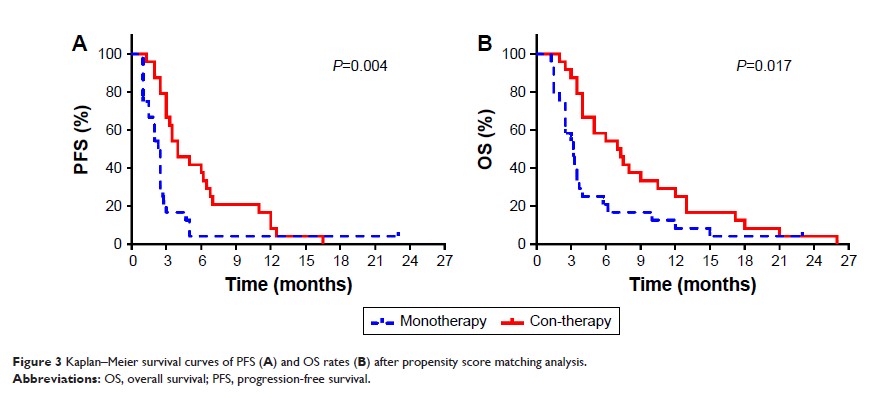108384
论文已发表
注册即可获取德孚的最新动态
IF 收录期刊
- 3.4 Breast Cancer (Dove Med Press)
- 3.2 Clin Epidemiol
- 2.6 Cancer Manag Res
- 2.9 Infect Drug Resist
- 3.7 Clin Interv Aging
- 5.1 Drug Des Dev Ther
- 3.1 Int J Chronic Obstr
- 6.6 Int J Nanomed
- 2.6 Int J Women's Health
- 2.9 Neuropsych Dis Treat
- 2.8 OncoTargets Ther
- 2.0 Patient Prefer Adher
- 2.2 Ther Clin Risk Manag
- 2.5 J Pain Res
- 3.0 Diabet Metab Synd Ob
- 3.2 Psychol Res Behav Ma
- 3.4 Nat Sci Sleep
- 1.8 Pharmgenomics Pers Med
- 2.0 Risk Manag Healthc Policy
- 4.1 J Inflamm Res
- 2.0 Int J Gen Med
- 3.4 J Hepatocell Carcinoma
- 3.0 J Asthma Allergy
- 2.2 Clin Cosmet Investig Dermatol
- 2.4 J Multidiscip Healthc

在晚期胃腺癌的第三线或后续线治疗中,同时使用阿帕替尼和多西紫杉醇与阿帕替尼单药治疗的比较:一项回顾性研究
Authors Lin H, Han D, Fu G, Liu C, Wang L, Han S, Liu B, Yu J
Received 7 November 2018
Accepted for publication 28 January 2019
Published 28 February 2019 Volume 2019:12 Pages 1681—1689
DOI https://doi.org/10.2147/OTT.S193801
Checked for plagiarism Yes
Review by Single-blind
Peer reviewers approved by Dr Andrew Yee
Peer reviewer comments 2
Editor who approved publication: Dr Sanjay Singh
Purpose: The aim
of this study was to assess the efficacy and safety of concurrent apatinib and
docetaxel therapy vs apatinib monotherapy as third- or subsequent-line
treatment for advanced gastric adenocarcinoma (GAC).
Methods: Patients,
who had received apatinib with or without docetaxel as third or more line
therapy for advanced GAC, were retrospectively reviewed. Propensity score
matching (PSM) analysis was performed to minimize the potential confounding
bias. Kaplan–Meier curve and log-rank test were used to analyze the survival.
Prognostic factors were estimated by Cox regression. Adverse events (AEs) were
evaluated using CTCAE 4.0.
Results: Thirty-four
patients received concurrent therapy, whereas 31 received monotherapy. The
median progression-free survival (PFS) and overall survival (OS) in monotherapy
and con-therapy groups were 2.5 and 4 months (P =0.002), 3.3 and 6
months (P =0.004),
respectively. After PSM, the median PFS and OS in the con-therapy group were
also superior to the monotherapy group (P =0.004 and P =0.017). Cox regression suggested that Eastern
Cooperative Oncology Group performance status (ECOG PS; HR =2.437, 95% CI:
1.349–4.404, P =0.003), CA199 (HR =1.001, 95% CI: 1.000–1.002, P =0.016), and
treatment options (HR =0.388, 95% CI: 0.222–0.679, P =0.001) had
significant effects on OS. Grade 3/4 toxicities in the monotherapy and
con-therapy groups were as follows: leukopenia (0% vs 8.8%), neutropenia (3.2%
vs 2.9%), anemia (9.8% vs 8.8%), thrombocytopenia (6.4% vs 2.9%), proteinuria
(3.2% vs 2.9%), aminotransferase (0% vs 11.8%), hyperbilirubinemia (9.8% vs
5.9%), hypertension (9.8% vs 5.9%), hand–foot syndrome (3.2% vs 8.8%), nausea
and vomiting (0% vs 11.8%), diarrhea (0% vs 5.9%), and fatigue (6.5% vs 2.9%).
Conclusion: Patients
with advanced GAC benefit more from concurrent apatinib and docetaxel therapy
than apatinib monotherapy.
Keywords: propensity
score matching, progression-free survival, overall survival
